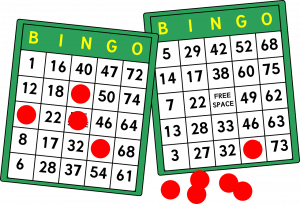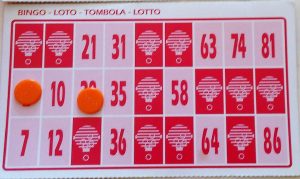
BINGO is a game where anyone can play free and have an enjoyable time. Besides, you can play at home or in a room with friends/family. The players are given a card with numbers on it and when the caller, the person in charge of shouting the numbers, calls a number, the players who have that number on their card have to mark it. When a player has all the numbers marked on their card, they have to shout “BINGO”. The player wins the game after their numbers are checked. This is another way of using our memory and perception.
Basic information
Definition:
Bingo is a game which each player has a card or several cards with numbers. A caller calls numbers chosen by drawing numbered balls or by an electronic randomiser. Players mark any numbers on their cards that are called, and the first player to mark a complete card wins.


Objectives
- The aim is to be the first player to cross out all the numbers on a bingo card.
- Recognize numbers and to be able to cross them out
The player can improve the following areas:
Duration
It depends on the ability of players to find the numbers. A typical game will last around 20 minutes.
Cost:
The online game is free to download or play from the Internet and the App Store.
You can also buy the game board to play it without a computer. It can be purchased second-hand from 7 Euros online or brand new from 13 Euros.
Reference
- Explanation for Bingo: https://en.wikipedia.org/wiki/Bingo_(United_Kingdom)
- Free On-line version: http://www.mundigames.com/multiplayer/bingo/
- Bingo benefits for seniors: http://www.homecareassistancetampabay.com/bingo-benefits-for-seniors/
- Background material: download this PDF:
Development
Participants
Participants’ profile:
- Dementia level: the game can be played by users from mild to moderate dementia level.
- Physical requirements: The player should be able to hold a pen or pencil to cross out the number.
Number of participants:
This game is usually for 2 or more people. The more players there are the more fun it will be.
Material and requirements
Materials required to play the game:
- A computer (if the user chooses the on-line version).
- Bingo cards.
- Bingo balls.
- A pen or pencil.
- Random ball selector.

Environment considerations:
- Good lighting levels. Avoid glare.
- A quiet room.
- A big table and a chair for each player.
Support needed
Professionals / relatives can:
- Explain the game instructions and their variants.
- Repeat the number called.
- Supervise the correct development of the game.
- Help players to find the numbers called.
Starting point:
The professional or relative should prepare the materials and give a card and a pen or pencil to each player.
Development:
Once the caller checks that each player is ready to start the game he or she starts moving the bingo balls and call out the numbers. The caller must check that players can hear clearly.
Players mark or cross out the called number on their cards with a pen or pencil.
When one player has marked all the numbers on his/her card then s/he calls the word “BINGO”. The card has to be checked by the caller and if the player does not make any mistake the player will win the round.
For a video demonstration see:
Additional information
Variants of the game:
There are different ways to play the BINGO. For example, instead of having numbers on the cards you could have relative’s names, animals or words.
You can have a printable bingo card where you can make your own cards game, for example please see: http://www.wikihow.com/Sample/Blank-Bingo-Card
Alternative games:
Another similar game is: ‘Keno game’
For information please see: https://en.wikipedia.org/wiki/Keno
For free on-line version please see: http://www.kenoonline.org/
You can also download Keno software for free and play without internet connection.
Assessment:
Once bingo has been called the professional/relative should check all the cards including the other players who have not won to verify that all their numbers are correctly crossed out.
The professional/relative must pay attention to how often numbers should be called so all players have understood.
Practical activities
![]()
